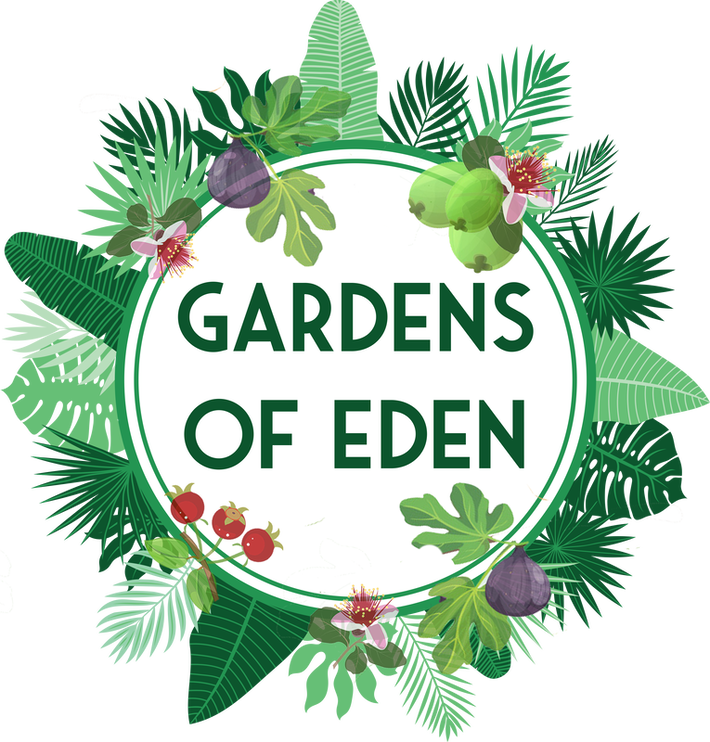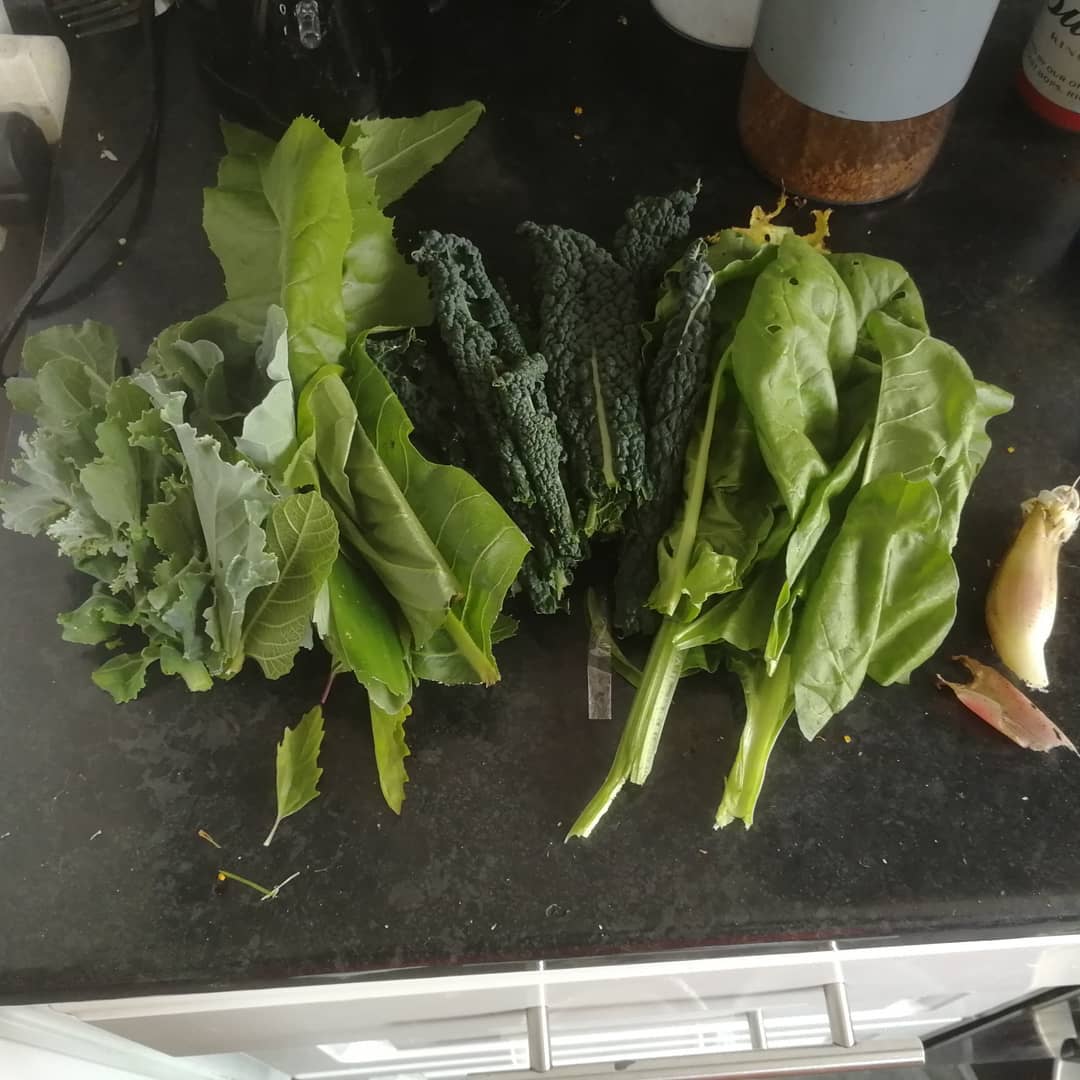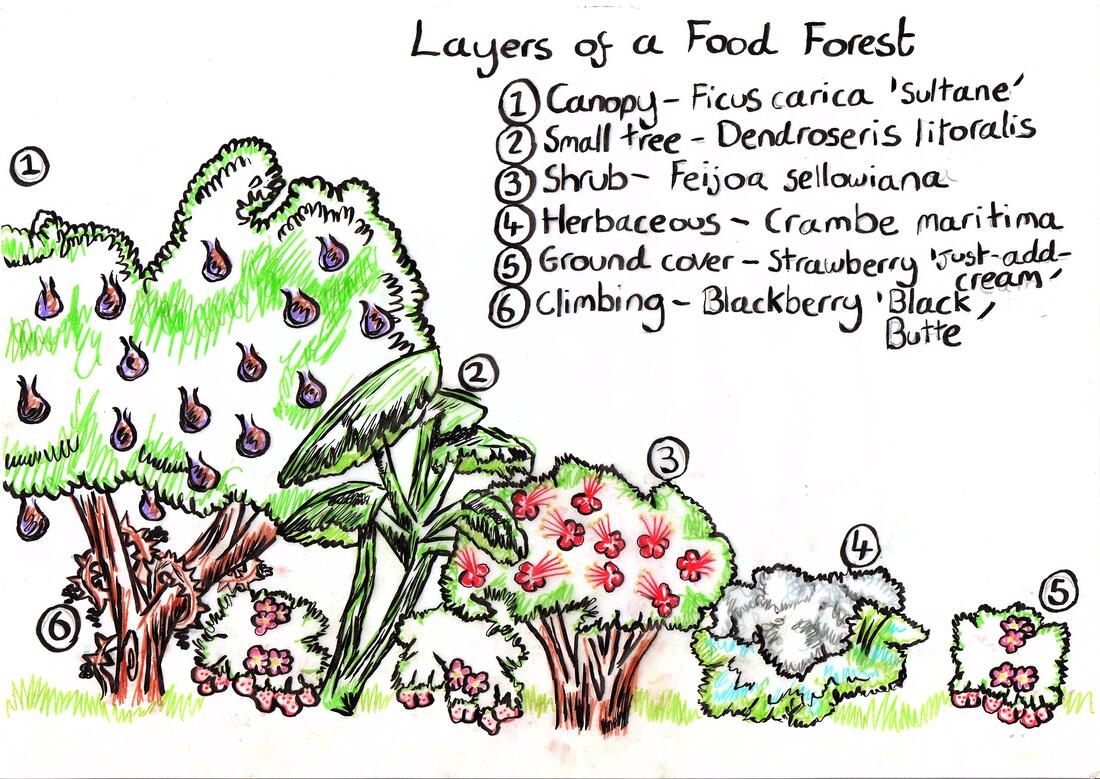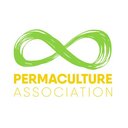|
Before I studied horticulture, I experienced insecure work and food banks. Thankfully, I was lucky enough to be able to remove myself from that situation. But... I feel like those experiences have helped me to appreciate the food security and piece of mind a Food Forest or an Edible Landscape can provide.
I'm at a stage now where the No-Dig For Victory Garden provides me with almost all of my fruit and veg. The only fruit and veg I do still buy are apples and bananas and the former I am hoping will eventually come from the garden. Yes, I still buy food, but all my onions, greens, herbs, salads and some fruits are picked from the garden when needed. This is portion of my food shopping I don't need to pay for anymore - all from a couple of hours maintenance every month. In addition, the food I am harvesting is sustainably produced and organic and I am eating flavours and varieties unavailable in shops. Imagine the potential to alleviate manutention and improve food security if sustainably produced, organic food was free and accessible to people in green spaces and community gardens. This is also achievable without needing to sacrifice beautiful borders or ecological planting. An Edible Landscape adopts conventional garden design principles as well as the methods used in Edible Forest Gardening. An Edible Landscape can look just like an ornamental garden AND provide habitats and food for wildlife too. Imagine if communities had access to free organic fruit and veg, produced sustainably in green spaces, whenever they needed it. No, it wouldn’t stop people from needing to buy food, but it could reduce the shopping bill, encourage people to eat more fruit and veg and provide piece of mind during times of uncertainty. Edible Landscaping in domestic gardens and green spaces bridges the gap between amenity horticulture and using horticulture to help find solutions for contemporary issues in our society. No-Dig For Victory in the 21st Century.
7 Comments
The first time I heard about the concept of a food forest or edible forest garden, I was already half way through a horticulture degree. Both fascinated by the idea and disappointed that I had only just discovered that such a thing even exists, I immediately began researching what a Food Forest was and, more importantly, how I could acquire one of my own.
A food forest is a permaculture idea and can be designed and created by using the concept of ‘Edible Forest Gardening.’ This method replicates natural forest ecosystems by categorising different plants and their habits into 7 different ‘layers’. Each of these layers fulfils a particular role based on the habit and form of the plant, layers such as: canopy, climber and ground cover. Edible and utilitarian plants are categorised into these roles and then added into a food forest planting scheme. The idea? That the plants will grow together and support each other, trees will provide support for the climbers, groundcover will cover the soil and supress weeds, deciduous trees will drop their leaves mulching the soil… its basically what I would envisage a garden of Eden to have been. What an innovative proposition, nature knows best, lets let natures principles govern the food growing process. At this stage during my education I was already pretty obsessed with exotic food crops, plants such as; Ugni molinae the Chilean guava, Actinidia arguta the cocktail kiwi, Zingiber mioga the hardy ginger, were all on my ‘to buy’ list as soon as I had access to some land. Imagine my excitement then, the prospect of combining exotic food crops with an ecosystem inspired growing system like an edible forest garden or food forest. A means to grow food that also utilises vertical growing space and thrives with biodiversity. Not to mention that the plants in a food forest are perennial, which means that the planting acts as a permanent food producing asset. I cant help but feel that this was a much more logical means to grow food, less fuss and harmonious with nature and wildlife. Conventionally, most of our fruit and vegetables today are grown on annual crops, plants that live out their life in a year and require re-seeding and re-growing every season. After each plant is harvested the plants are disposed of and the soil is sprayed or dug over and new seeds planted. The tilling of soil is actually an unnatural process, the advanced network of mycelium and microbes beneath the soil is churned up and forced to start over. Whereas in nature these networks of macro and microorganisms would remain undisturbed. Also, tilling causes soil and nutrient run off which can be harmful to the environment and ecosystems. Synthetic fertilizers run of into the water table and soil itself is lost into the wind and water. For example, when synthetic nitrogen runs off into water from agricultural systems it can cause algae to grow disproportionately in bodies of water. This then interferes with aquatic ecosystems as the algae outcompetes other species and covers the surface of the water, depriving organisms of light. Generally, in efficient agricultural systems the grower will grow rows of one species in a field or area, also called a ‘monocrop’ for ease of growing and harvesting. This method is extremely efficient but has significant ecological disadvantages. Monoculture farms are vulnerable to pests and diseases, by planting a whole field of one species we inadvertently create the perfect habitat for pests the crops are susceptible too. Imagine being a cabbage white butterfly, stumbling across an entire field of brassicas, the butterfly is surrounded by habitats and food. If one cabbage gets infected the entire crop is risk. As a result, pesticides and weed killers are commonplace in conventional farms which kill insects and have been linked to cancer and ecological damage. When compared to other forms of planting, monoculture is an ecological desert. It’s fairly useless at providing food and habitats for wildlife, an entire field of one specific cultivar of one crop can only support a limited number of species. When you compare this to a wildflower meadow which would contain hundreds of different beneficial plants, monoculture is far worse at supporting biodiversity. This, for me, is part of the appeal for Food Forest planting systems; by planting Food Forests and moving towards a perennial diet we can alleviate the ecological damage caused by conventional agriculture. Food Forests use perennials, plants are planted once and left alone so these systems eliminate the necessity for tilling and the damage it causes entirely. Also, because a Food Forest contains a diverse range of plants the need for pesticides is reduced dramatically if not completely eradicated. For example, if the perennial kale in a Food Forest planting scheme had been eaten by cabbage white, the gardens crop of perpetual spinach and Caucasian spinach would be unaffected. In addition, by interplanting everything together you can take advantage of companion planting. Alliums for example can be great at deterring pests, plant perennial kale with welsh onion and the onion will help deter cabbage whites. Food Forests also present an opportunity to grow crops and flavours, unavailable anywhere else. I think there is something quite romantic about picking fresh figs, persimmons, and guavas straight from the tree, outside in a UK garden and this is entirely possible with Food Forest planting schemes. Food Forests are also resilient to environmental changes, an established Food Forest isn’t likely to be too affected by droughts or unprecedented cold weather, whereas this could be apocalyptic for a monoculture harvest. This resilience is particularly pertinent now, during a climate crisis. For me it seems like such an obvious transition, a perennial diet, food grown in our gardens and green spaces, making sustainably produced organic food free and accessible to everyone and simultaneously alleviating our dependency on conventional, ecologically destructive means of feeding the population. Food Forests are a win win and can look beautiful too. It’s been 4 years since I first discovered the concept of Food Forest and I am still just as fascinated. I have since graduated, founded Gardens Of Eden and been creating Food Forests and Edible Landscapes for myself and clients for 3 years. The passion has only grown and I hope to pass on as much as I can to others. I believe designing and creating Food Forests and Edible Landscapes could change the world for the better. Suburban front gardens, greenspaces, roundabouts and country manors. Lawns occupy more space than any other crop in the United States and you could be forgiven for assuming that statistic applies to the UK as well. But why? There is no doubt that lawns have their place; in parks, for sport, particularly golf, and even for just relaxing in the sun with a picnic, but is that the only reason? I mean, I loved sunbathing on my back lawn during last year’s glorious heat wave, but really? America’s most cultivated crop? More than wheat, more than potatoes, more than maize, oats, or any other irrigated crop. Lawn and turf grass, bigger than them all?
The truth is that lawns made their obnoxious transition from ‘livestock dinner’ to ‘suburban must have’ by … well, by being relatively useless. In the early 17th century lawns became a status symbol for the aristocracy and gentry. The very wealthy allocated huge spaces in the front of their decadent homes for lawn. Lawn to demonstrate the lack of necessity to grow food or keep livestock, which is what would have been typical at the time. Lawns also demonstrated the owner’s wealth with their high-maintenance. Servants with scythes would be required to keep the lawn, numbers of people cutting huge areas by hand. This kind of commodity was accessible only to those with extreme wealth, vast amounts of land and the societal implications that came with such things. It’s not surprising then that when the lawnmower was invented in 1830 everyone wanted a piece of high society, and before long the lawn had become a cultural norm in every neighbourhood in the western world. So what’s the harm? I mean, who doesn’t like the smell of freshly cut grass? And it’s not like we are lacking growing space to feed a growing population ... well. Admittedly, a space occupied by turf grass is better for the local ecology than concrete. The existence of living plant matter acts as a carbon sink, sucking carbon from the atmosphere and storing it in the soil. However, as well as being disproportionately treated with chemical fertilizers and weed killer, lawns contribute very little to wildlife and overall ecological diversity compared to any other choice of planting. What’s more, the labour and watering requirements for lawns are very high, considering the lack of a quantifiable ‘yield.’ As a gardener, I can’t help but see lawns as a bit of a wasted opportunity. I imagine wild flower meadows as low-maintenance, pollinator loving alternatives. Better still, why not intermingle perennial food crops, intertwined with an abundance of floral colour and fragrance? Cut the cost of the food shopping, or even help yourself if it’s in a public space. I see lawn space as an opportunity to contribute to solutions of contemporary issues. Food banks on the rise, why not provide a free and nutritious food source in place of lawn in our public spaces? Pollinators and wildlife in decline? Why not use our gardens as ecological havens? Filling them with a diversity of pollinator plants or even a bug hotel. This could be done tastefully too. Green space planting designed to be beautiful with an edible twist surrounded by low-maintenance wild flower meadows. In my own garden in St Austell, Cornwall, the front garden was re-purposed into an ornamental yet edible suburban micro-farm. A combination of perennial and annual planting beds provided a constant supply of salads, beets, chives, rhubarb, chard, Chilean guavas, garlic, ginger, saffron and strawberries, and no, my garden isn’t a muddy allotment; it’s a stylish contemporary ornamental garden with a Willy Wonka twist! Throughout history, before lawns dominated the suburban garden market, land was seen as a resource. A canvas from which food and, by extension, capital could be generated. The Spartans even regarded land and the resources to grow one’s food as a birth right, allocating areas of land to every citizen after they reached adulthood. Is land access no longer a human right? Do we not all have a collective right to nurture the land around us and control a portion of our food supply? With my business GardensOfEdenUk, I aim to bring edible landscaping to the forefront of garden design. Edible gardening need not be achieved at the expense of beautiful borders and flowers. They are both important components of a bigger idea; multi-purpose, ornamental, edible and ecological gardens, providing a food source, improving biodiversity and simply looking great. There will always be a place for the lawn; places to sit and play sport, but maybe it’s time to rethink a portion of allocated lawn space. A portion that could be put to more imaginative, purposeful use. By Zac Harris BSc Horticulture (Garden and Landscape Design) |
AuthorZac Harris BSc Horticulture (Garden and Landscape Design) Archives |
|



 RSS Feed
RSS Feed


